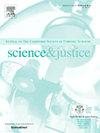在模拟咖啡环境下的潜在手印恢复:对一次性无孔塑料和半孔纸杯氰基丙烯酸酯熏烟的探索性研究
IF 2
4区 医学
Q2 MEDICINE, LEGAL
引用次数: 0
摘要
从饮料容器中提取潜在手印是法医调查的一个重要方面,但基质性质和饮料温度对手印形成的影响尚未得到充分研究。本探索性研究采用氰基丙烯酸酯(CA)熏烟法,在近似典型咖啡环境的条件下,评估了由无孔塑料和半孔纸制成的一次性饮料杯上潜在手印的发展和质量。参与者在受控的教室环境中喝下热饮和冰饮后,共收集了255个杯子(107个塑料杯,148个纸杯)。在标准化的实验室条件下进行CA熏烟,并对冲洗好的指纹进行5级评估(1级=质量差,5级=质量很好)。分析显示,与纸杯相比,塑料杯上的潜在手印更多、质量更高,5级指纹仅在塑料表面上观察到。在塑料杯中,透明杯比半透明杯产生更多可识别的指纹。这些发现强调了孔隙度、表面纹理和处理行为对CA烟熏过程中手印残留物保存和聚合的潜在影响。本研究强调了塑料饮料杯作为CA烟熏潜在手印回收基质的有效性,而半多孔纸杯可能需要不同或增强的开发技术。为了避免烫伤,反复握住热饮杯可能会机械地破坏残留物或缩短处理时间,从而减少总体残留物沉积。在未来的研究中,应该解决诸如相对同质的参与者池、依赖单一审查员评分以及受控的环境条件等限制。尽管如此,这项工作为普通饮料容器的法医可行性提供了见解,并为在真实的咖啡馆环境中进一步调查提供了基础。鼓励未来的研究扩大参与者的多样性,探索不同的环境条件,并比较不同的手印开发方法,以优化实际应用和案例工作成果。本文章由计算机程序翻译,如有差异,请以英文原文为准。
Latent fingermark recovery in a simulated café setting: an exploratory study of cyanoacrylate fuming on disposable nonporous plastic and semiporous paper cups
Latent fingermark recovery from beverage containers is an important aspect of forensic investigations, yet the influence of substrate properties and beverage temperatures on fingermark development remains understudied. This exploratory study assessed the development and quality of latent fingermarks on disposable beverage cups made of nonporous plastic and semiporous paper using cyanoacrylate (CA) fuming, under conditions approximating a typical café environment. A total of 255 cups (107 plastic, 148 paper) were collected after participants consumed hot and iced beverages in a controlled classroom setting. CA fuming was performed under standardized laboratory conditions, and developed prints were evaluated on a five-grade scale (Grade 1 = poor quality, Grade 5 = very good quality). Analyses revealed significantly more and higher-quality latent fingermarks on plastic cups compared with paper cups, with Grade 5 prints observed exclusively on plastic surfaces. Among plastic cups, transparent cups yielded more identifiable prints than translucent ones. These findings highlight the potential impact of porosity, surface texture, and handling behaviors on fingermark residue preservation and polymerization during CA fuming. This study underscores the effectiveness of plastic beverage cups as substrates for latent fingermark recovery with CA fuming, whereas semiporous paper cups may require different or enhanced development techniques. Repetitive gripping of hot beverage cups—intended to avoid burns—may mechanically disrupt residues or shorten handling times, thus reducing overall residue deposition. Limitations such as the relatively homogeneous participant pool, reliance on a single examiner for grading, and controlled environmental conditions should be addressed in future research. Nonetheless, this work offers insight into the forensic viability of common beverage containers and provides a foundation for further investigations in real café settings. Future studies are encouraged to expand participant diversity, explore varied environmental conditions, and compare alternative fingermark development methods to optimize practical applications and casework outcomes.
求助全文
通过发布文献求助,成功后即可免费获取论文全文。
去求助
来源期刊

Science & Justice
医学-病理学
CiteScore
4.20
自引率
15.80%
发文量
98
审稿时长
81 days
期刊介绍:
Science & Justice provides a forum to promote communication and publication of original articles, reviews and correspondence on subjects that spark debates within the Forensic Science Community and the criminal justice sector. The journal provides a medium whereby all aspects of applying science to legal proceedings can be debated and progressed. Science & Justice is published six times a year, and will be of interest primarily to practising forensic scientists and their colleagues in related fields. It is chiefly concerned with the publication of formal scientific papers, in keeping with its international learned status, but will not accept any article describing experimentation on animals which does not meet strict ethical standards.
Promote communication and informed debate within the Forensic Science Community and the criminal justice sector.
To promote the publication of learned and original research findings from all areas of the forensic sciences and by so doing to advance the profession.
To promote the publication of case based material by way of case reviews.
To promote the publication of conference proceedings which are of interest to the forensic science community.
To provide a medium whereby all aspects of applying science to legal proceedings can be debated and progressed.
To appeal to all those with an interest in the forensic sciences.
 求助内容:
求助内容: 应助结果提醒方式:
应助结果提醒方式:


